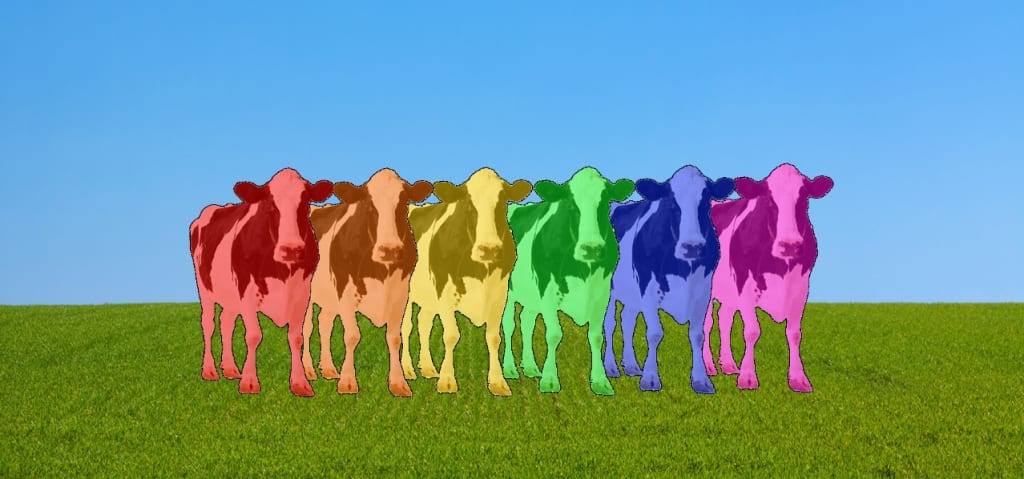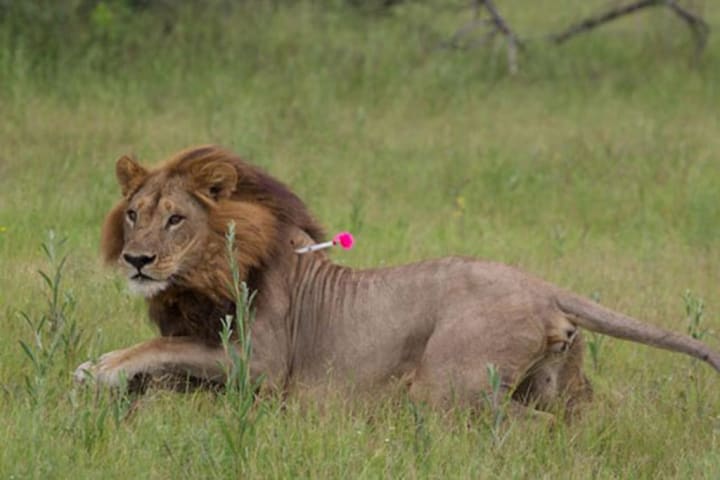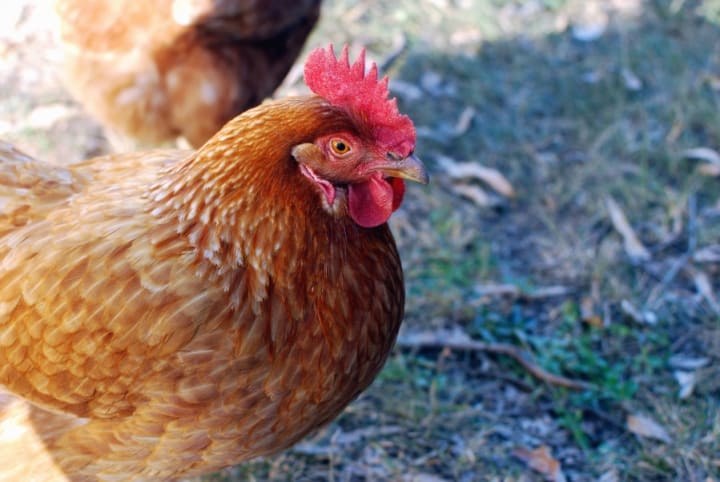Top Ten LGBT+ Animals
Nature doesn't care about your philosophical objections.

Have you ever heard someone say that being gay isn’t “natural?” Well, I have some bad news for them: nature is gay AF. Our world has numerous examples of animals that change gender, engage in same-sex activity, and throw gender norms out completely. Here’s my top ten animals from across the LGBT+ spectrum.
1. Lesbian Cows
I grew up in a farming community, and bizarrely, I had never heard of lesbian cows until one day, at the tender age of 17, walking across the marshes with some friends, we encountered a cow threesome. This was something of an eye-opener for me, with nature transgressing two of my conservative upbringing’s sexual mores in one go. I naively asked a friend, “er, are they all bulls?” (assuming that only the male animal would be doing the mounting), to which they responded, “no, don’t be silly; they’d fight. Have you never seen gay cows before?” Have you never seen gay cows before—what a question. My friend’s explanation was that it serves as a practice run for the real thing, because bulls are damn heavy and they need to build their strength up. However, there are other theories, including that it’s a stress reaction to being kept in captivity (although the cows I saw were free-roaming) or that it’s an aberration and cows are strictly against homosexuality (according to the Tanzanian president – yes, really). Apparently it's a common behaviour when cows are in heat. Maybe the cows just enjoy a bit of lady-loving—although how we can ascertain their true feelings, I’m not sure.

Filthy Cows.
2. Whiptail Lizards
Whiptail lizards are an incredible species, because they are all female. No boys allowed in this girl gang. And that means the species is 100 percent lesbian! They reproduce asexually, but they can’t do it by themselves. In order for their eggs to begin division to grow into a baby lizard, two females must partake in same-sex love to initiate the process. They are possibly the only species where homosexuality is a necessary trait for the species to endure.

Aw, they look happy.
3. Transgender Lions
Some lionesses in Botswana have been observed to grow manes, deepen their roars, and engage in male behaviours. To clarify, these female lions acted and looked like regular females previously, but they have since transitioned towards male. They do still engage in some female-typical behaviours, but the traits they have adopted are not usually seen in female lions—including increased scenting, mounting other females, and killing cubs of another pride. They seem to be the result of increased testosterone levels, which may occur as a result of a genetic mutation. This adoption of male characteristics also serves the purpose of protecting the pride should the male leader die. So there’s an evolutionary reason for this gender shift. Nature seems to sort itself out.

Trans lion, with added tran-quiliser dart, by the look of it.
4. Bonobos
Bonobos are well known for their voracious sexual appetites, but did you know that they are almost universally bisexual? Sex in bonobo land is used as a tool of bonding and conflict resolution, for fun, and even as a greeting. It’s a defining part of their society, and they are remarkably chilled out about it. Perhaps we can learn a thing or two from our bonobo cousins.

Happy Families.
5. Gender-Changing Fish
The most well-known case of this is in clownfish, where a shoal has just one egg-laying female that gets to mate with the most dominant male. As well as their ability to change gender, clownfish operate a strict matriarchy, flipping the usual gender roles upside down. The female ruler selects just one male from her harem to mate with, forming a monogamous pairing until one of them dies. The female lays hundreds of eggs at a time, and they are cared for by the male (very progressive, these clownfish, although perhaps not as devoted as pregnant seahorse fathers). All of the babies hatch as males, so where do we get female clownfish from? Easy. When the female head of the household dies, the dominant male simply changes gender and selects the next male in the hierarchy as their new partner. If the female outlives her male partner, the next male in line steps up without needing to switch gender—this time.

WE FOUND NEMO! By Jenny from Taipei (Be careful honey....Uploaded by PDTillman) [CC BY 2.0], via Wikimedia Commons
6. Intersex Chickens
Rarely, chickens are born with characteristics of both sexes, split exactly halfway down their body. One half will look female, and the other will appear male. Genetic testing of specimens shows that this is happening on the inside, too. All the cells on one side of the chicken’s body are female, and on the other side they are all male. They usually only have one set of genitals, though, and these are either male or female, not a combination. This phenomenon is called gynandromorphism, and it exists in other bird species. We don’t know how common it is, because not all bird species display noticeable differences between the sexes. For now, it’s been observed in zebra finches, pigeons, and parrots – but how you’d identify this by the naked eye in, say, a pigeon is anyone’s guess.

It's meant to be incredibly hard to accurately sex chicks, and is a skill possessed by a talented few. So what happens if they find a gynandromorph?
7. Gay Sheep
Around 8-10 percent of rams are only interested in the company of other gentlemen sheep, and another 18-22 percent are bisexual. There are observed differences in the brains of gay and straight sheep—the gay sheep have smaller hypothalamuses. There don't seem to be figures available for ewes, who probably don't get much say in the mating process. As for many animals, their terms of consent are a bit looser than ours. But same-sex activity has been observed between female sheep, mainly in the wild. Captive and wild rams are known to be up for some ram-on-ram action, even participating in huge ram orgies (I swear this is true).

Out and Proud.
8. Multi-Gendered Lizards
Side-blotched lizards weren’t satisfied with just two genders, so they added in a few extra. Altogether, there are five different sexes, distinguished by the colour of the stripe on their throat, and their different mating and general behaviours; the way they interact has been compared to a game of rock, paper, scissors. There are two different female genders, and three different male genders, all varying in terms of their aggressiveness, territorial nature, and egg-laying behaviour—and it's all driven by their respective levels of testosterone. They want to be careful about toxic masculinity. There's far too much anger going on here.

This blue-throated dude guards a small territory and is moderately aggressive. Not as tough as the orange-throated ones, though.
9. Intersex Marsh Harriers
Around 40 percent of male Marsh Harriers actually possess a combo of male and female traits. While this portion of their population is genotypically male, they exhibit female features and present as “less-threatening” than ordinary males. They retain female-pattern plumage into adulthood, and adopt female-like behaviours, which is thought to reduce conflict and competition between birds. The less-aggressive males are able to breed with females with less trouble from other male birds, and the female birds can do their thing with less unwanted male attention due to the protection of the male birds disguised as ladies. It would seem that the benefits of male feminism have really sold themselves to the Marsh Harriers (someone tell the side-blotched lizards).

This is a male marsh harrier. He looks scary - I can see why the females aren't too keen. By Sumeet Moghe [CC BY-SA 3.0], from Wikimedia Commons
10. Pansexual Hermaphroditic Earthworms
I couldn’t have a list of LGBT+ animals and not include the sexy, weird, and incredible earthworm. All earthworms have both sets of male and female reproductive organs, making them true hermaphrodites. They can also mate with any other earthworm they choose, even getting it on in a big, slimy earthworm orgy. It’s literally slimy. The worms writhe up together and secrete mucus from their bodies, then both squirt their sperm into the sticky, slimy goo they’ve covered themselves in. The sperm then make their way into each earthworm’s hoo-ha (not a scientific term), and both earthworms are hopefully preggo. But in order to finish the act, each worm gives off even more mucus from the “saddle” segment of their body, which travels the length of their body, scooping up all the eggs and sperm, forming a cocoon which the worm then leaves in the soil. After a few weeks, baby pansexual hermaphrodite earthworms emerge from the sac, ready to grow up and start their own slimy earthworm love-in.

BOOM-CHICKA-WAH-WAH
Nature in All Its Glorious Gayness
So there we have it; a snapshot of nature at it’s filthiest, gayest, and most beautiful. Don’t ever let anyone tell you that being queer is unnatural—nature’s been proving otherwise for millennia. And these were just my ten favourite examples. There's so much more gender and sexual variety in nature. It's a shame they don't teach this in schools. It's fascinating.
About the Creator
Katy Preen
Research scientist, author & artist based in Manchester, UK. Strident feminist, SJW, proudly working-class.






Comments
There are no comments for this story
Be the first to respond and start the conversation.